Ravel, Quatour pour intruments à cordes, First Movement
José Rodríguez Alvira
Ravel completed his string quartet at the age of 28. Dedicated to his teacher Gabriel Fauré, it was presented to the Prix de Rome and the Paris Conservatoire with little success. Yet Debussy wrote to Ravel: "Au nom des dieux de la musique, et au mien, ne touchez à rien de ce que vous avez écrit de votre Quatuor" ("In the name of the gods of music and in my own, do not touch anything of what you have written in your Quartet").
The first movement is in sonata form. This graphic shows the formal structure. Click on any section for more information:
Exposition, first section
The movement begins with the first theme (T1). This theme has two four measures phrases presented by the first violin. The first phrase begins with an A and ascends to a C. The second phrase begins with an Eb and descends to a second line G:

The first phrase uses the notes of the F major scale. The second phrase uses the Eb Mixolydian mode:

Both phrases share rhythmic motives.
In the first phrase, the cello plays an ascending F major scale doubled by the second violin a tenth above. We will label the motive played by the first violin in the first measure m1 and the first four notes played by the cello m2:
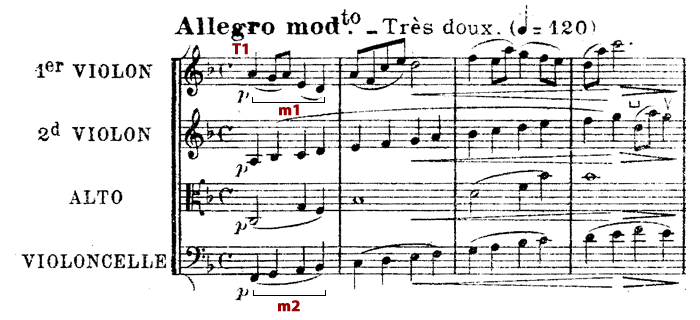
After the first theme, a dialog between the two violins starts in measure 9:
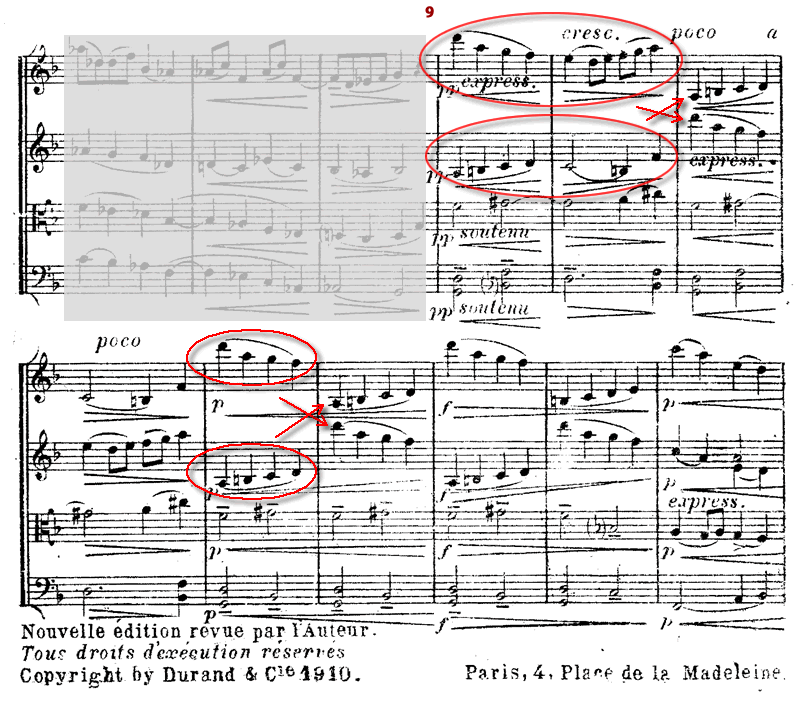
The thematic material played by the first violin is a variation of m1. It may not appear to be a new theme, but Ravel will develop this theme later in the movement so we will identify it as T2 and its first 4 notes as motive m3:

Motive m2 appears in the ascending scale played by the second violin in measure 9. This is the harmonic progression used:
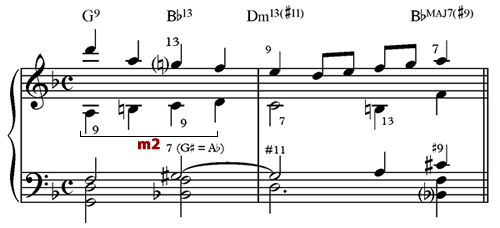
This passage ends with the dominant chord of F and leads to a variation of the first theme T1 in measure 17. The first violin begins with the first two notes of T2 (a confirmation that they are related). The viola plays the first notes of m1. Three measures prepare the transition to the second section (measures 21 to 23):
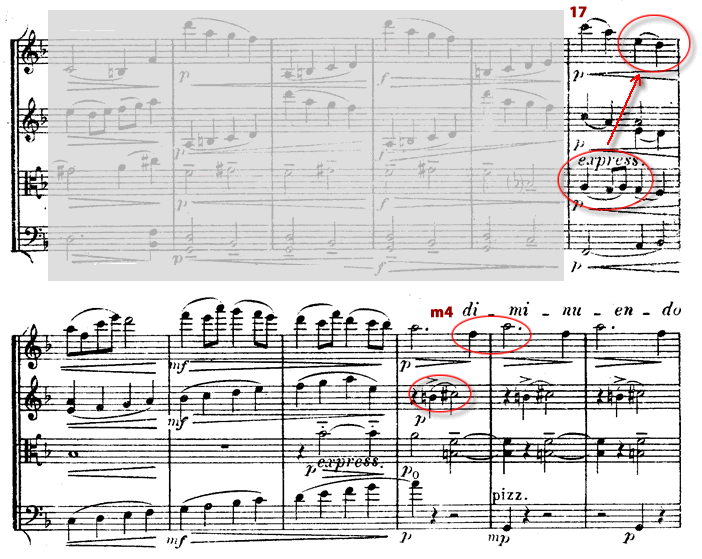
The motive that appears in measure 21 will be labeled m4 as it will be used later in the movement.
Measures 21 to 23 use the whole tone scale over a G dominant chord with ninth and sharp eleventh:

Listen to this section:
Recording courtesy of Cassatt String Quartet
Transition
In the first measures of the transition to the second section, the first violin makes variations of T1. We find m2 in the second violin transformed by diminution. A new motive (m5) is shown in the second violin. This section is not organized following the time signature: a first 6 beats block is repeated in the third beat of measure 25. Measure 28 shows two new repetitions of the A block followed by block B:
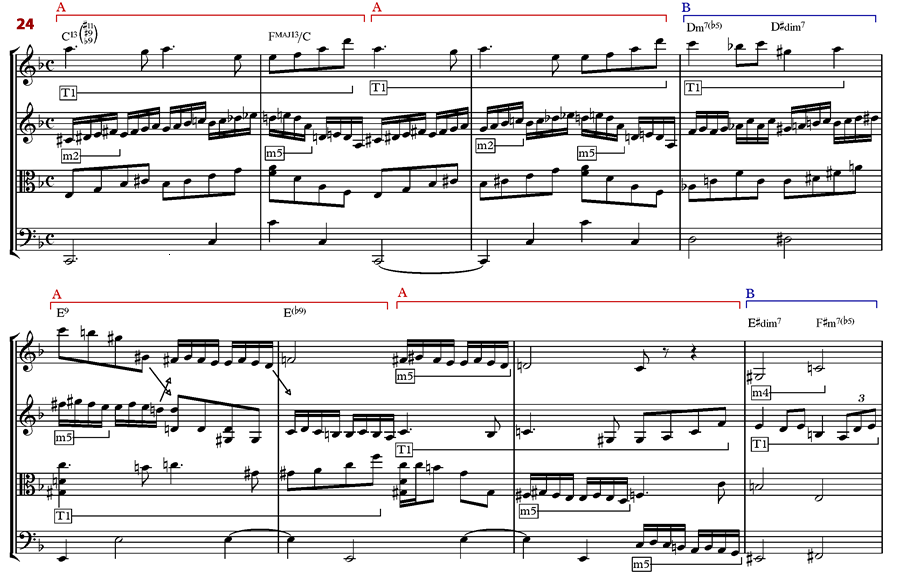
The first A block is based on the diminished scale (semitone-tone) over a C dominant chord with major and augmented ninth, augmented eleventh and major thirteenth:

In the first two beats of block B (measure 27), Ravel uses a D half diminished chord. The first violin develops motives from T1. In beats 3 and 4 the chord changes to a D# diminished seventh chord and the diminished scale reappears. Using the D# as first note the scale is a tone–semitone diminished scale:
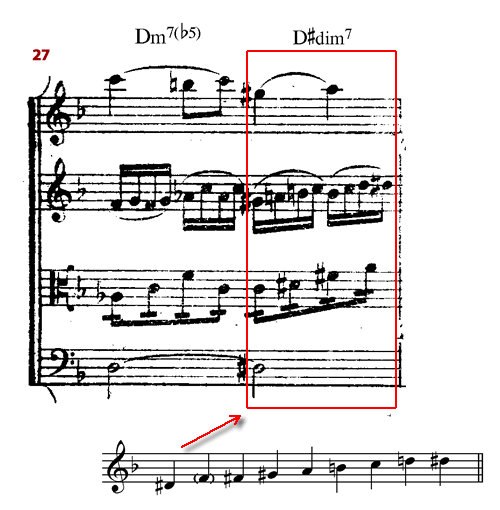
In measures 28 to 31 the two A blocks followed by a B block scheme is repeated. The chord is now an E dominant chord with major ninth that changes into a minor ninth. The T1 motives goes now to the viola and the second violin:
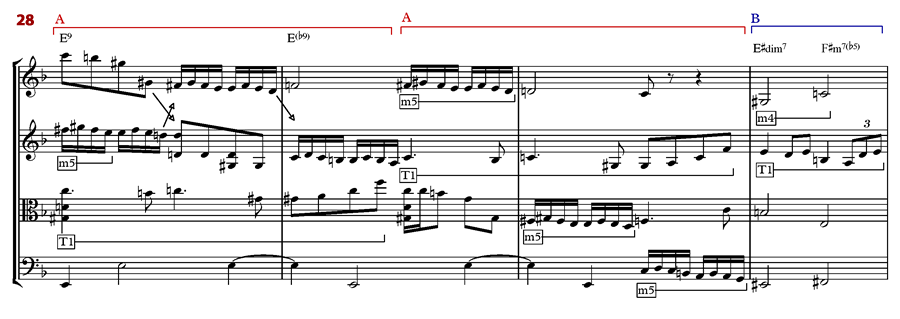
In measure 32 the block reappear but reduced in size. The semitone–tone diminished scale starting in C# is used in the A blocks:
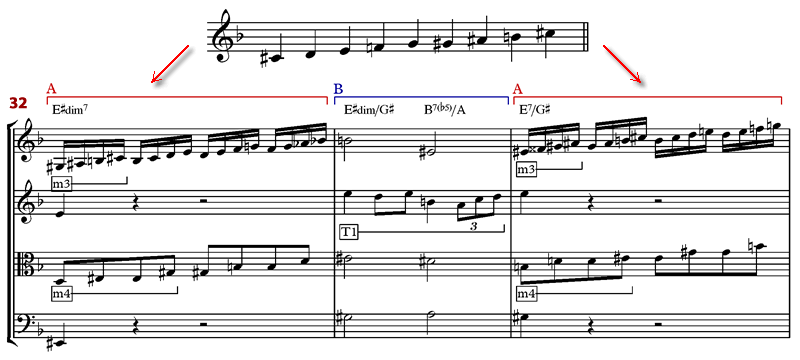
Ravel has already used the 3 possible diminished scales. This scale is a symmetric scale, any other transposition will create a scale that shares notes with one them:
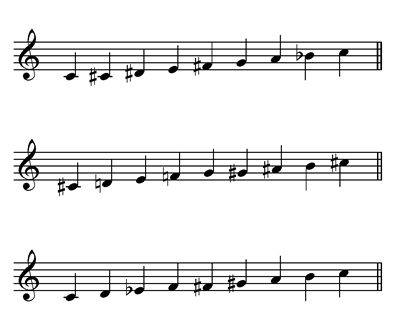
In measures 35 to 38 the first violin develops motive m1. A C# sharp minor and an A# diminished chords are used in measures 35 to 36 before returning to the diminished scale in measures 37 and 38. Two diminished scales are used, one by the viola, and another by the other instruments:
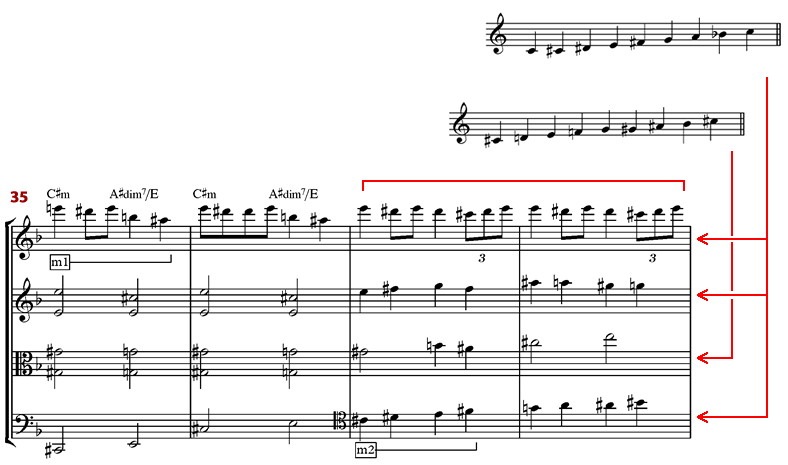
A climax is reached with the m5 motive in the first two violins and motive m4 in the cello:
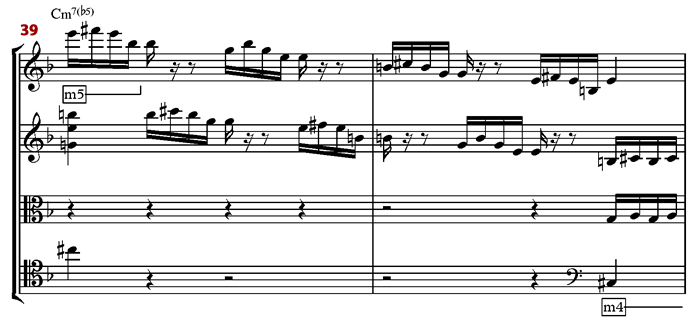
In measures 41 to 43 two diminished scales are simultaneously used:
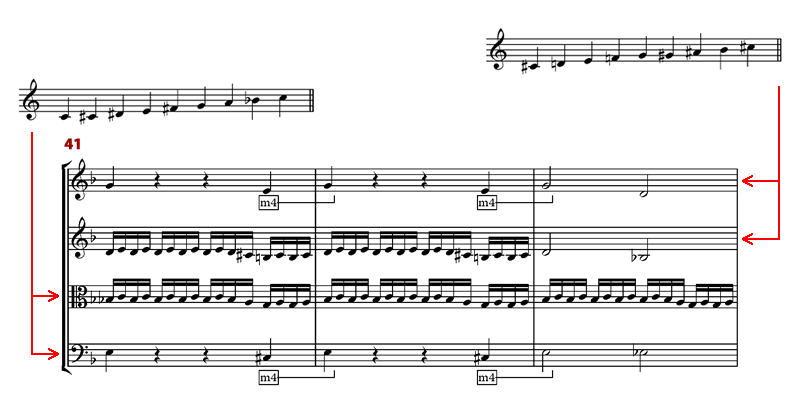
The following measures prepare the second section. A dominant chord is the main chord in the section:
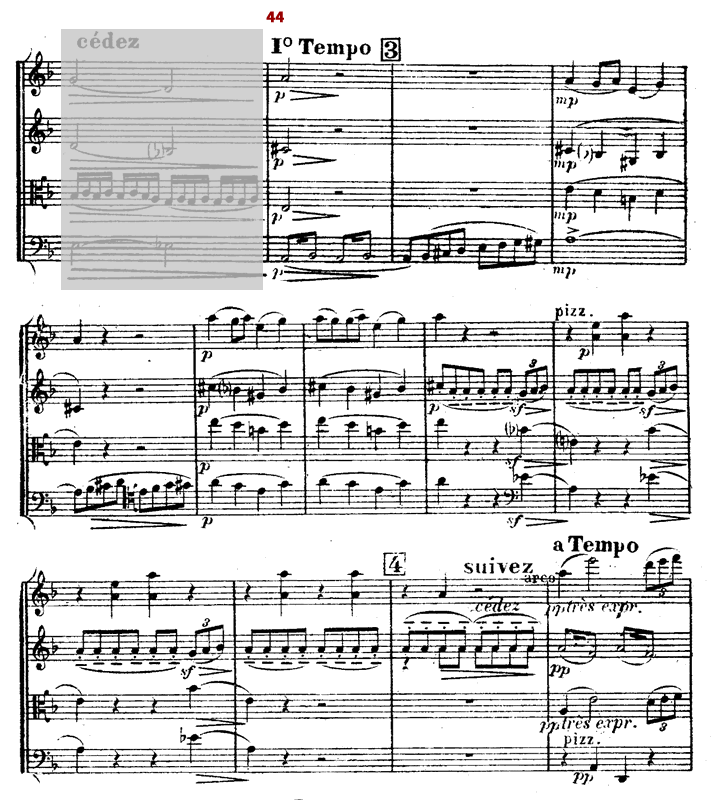
Listen to this section:
Recording courtesy of Cassatt String Quartet
Exposition, second section
The second section is relatively short. The 8 measures theme T3 is played by the first violin and the viola. The second violin in measure 63 repeats a shorter, 6 measures long version. This section leads directly to the development (rehearsal number 5):
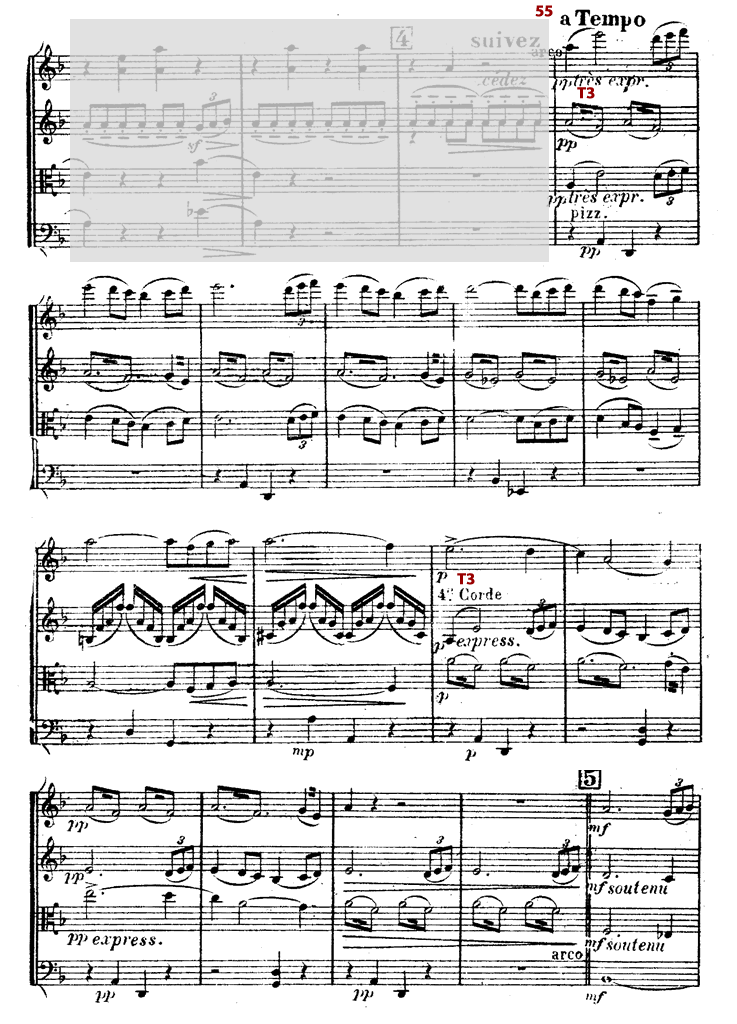
Theme T3 appears over a D minor chord in the first four measures followed by the Eb major seventh, G dominant with ninth and A dominant with minor thirteenth chords:
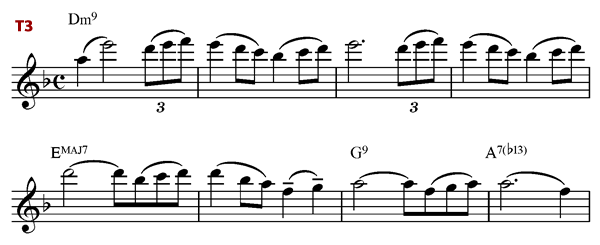
Theme T3 is related to previously presented thematic material:
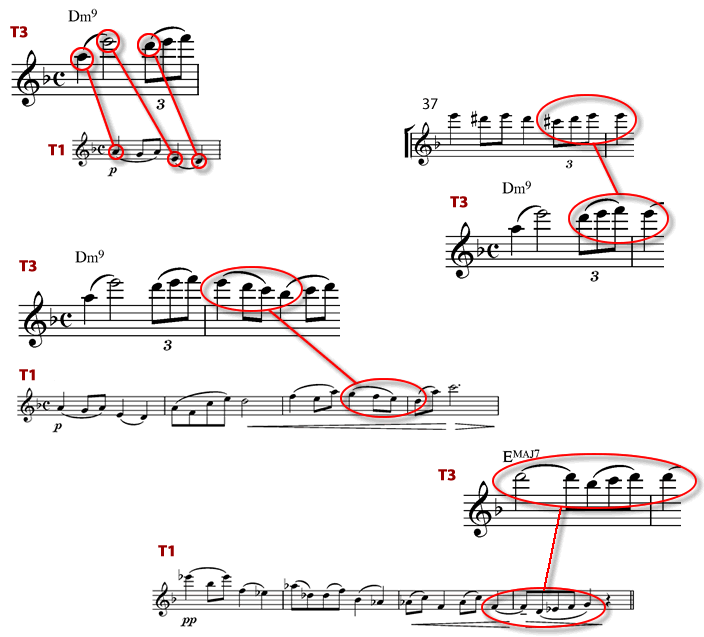
Several chord extensions are emphasized by the theme: the ninths of the D minor (E) and G dominant chords (A), the major seventh of the Eb chord and the minor thirteenth of A dominant chord (F).
Listen to the exposition:
Recording courtesy of Cassatt String Quartet
Development
The development begins as a continuation of the exposition. The following table resumes the use of T3 and T1 in the first 15 measures:

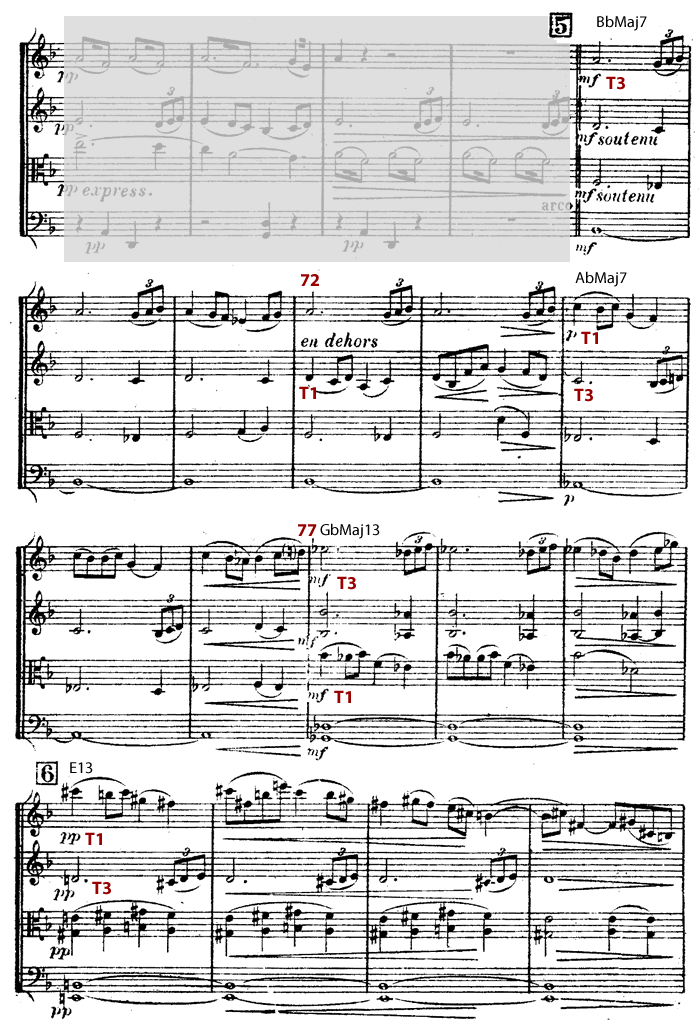
Here are the chords used in measures 69 to 83:

The mood changes in measure 84. Over a D minor seventh chord the viola presents theme T2. This theme appeared for the first time in measure 9 in a shorter version:
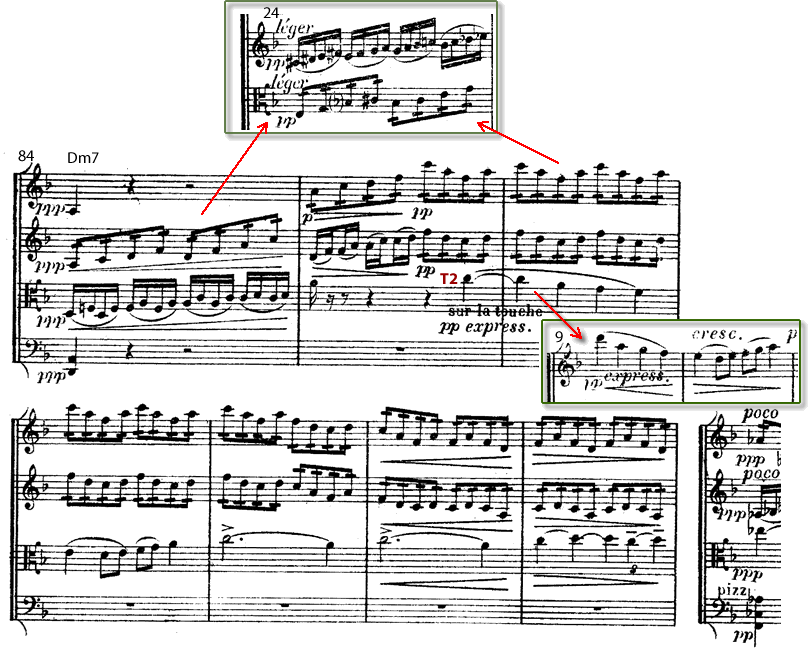
The 7 measures long block is repeated over a F half diminished chord, The T2 theme is now played by the first violin and cello:
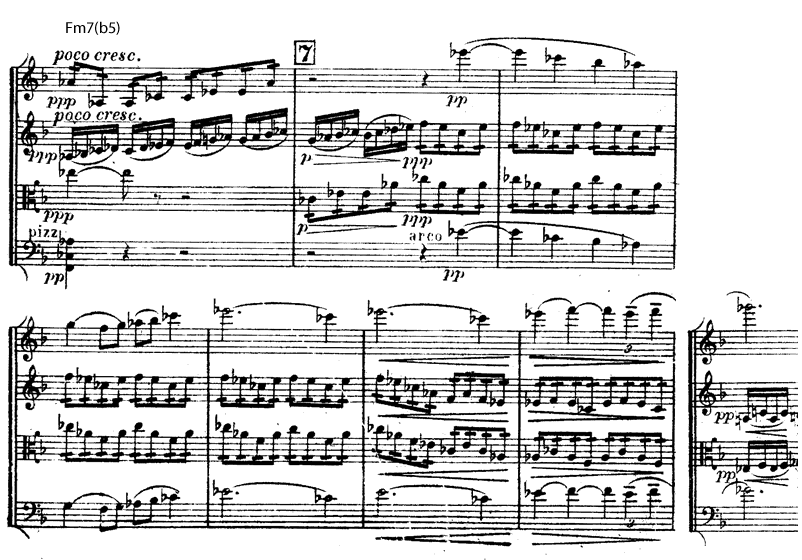
Tension increases. Ravel presents motive m4 in measures 98 to 101, before developing a new theme (T4) in measure 102. We will use T4 to identify this theme although it is built using previously presented motives:
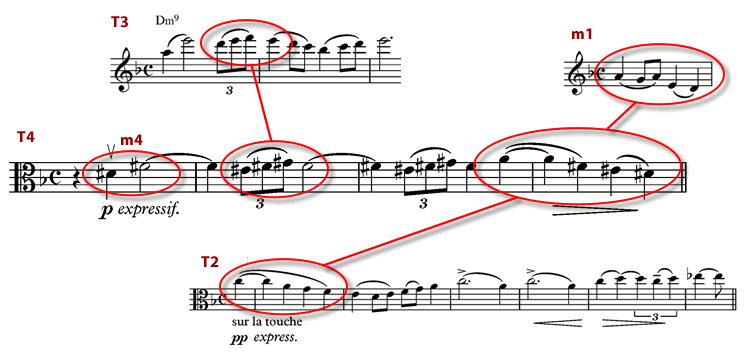
Theme T4 appears in 3 occasions. The size changes in each appearance but it always appear in sections using the same number of measures. T4 is played by the viola in measures 102 and 110 and by the violin and cello in measure 106:
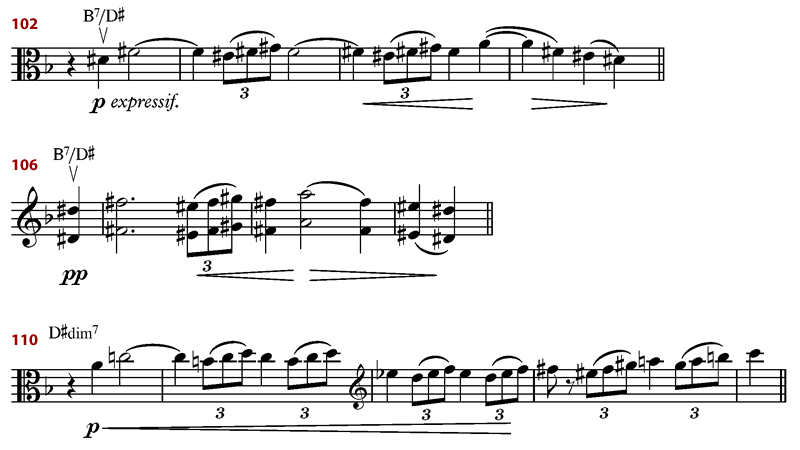
A D# pedal with a B dominant harmony is established from measure 102 to 110. A tone-semitone diminished scale is used. A C# that is not part of the scale appears as a chromatic note in the second violin (measures 104-105 and 108-109) and the first violin (measure 109).
The cello starts an ascending diminished scale in measure 110. Starting on measure 114 the first violin plays m1:
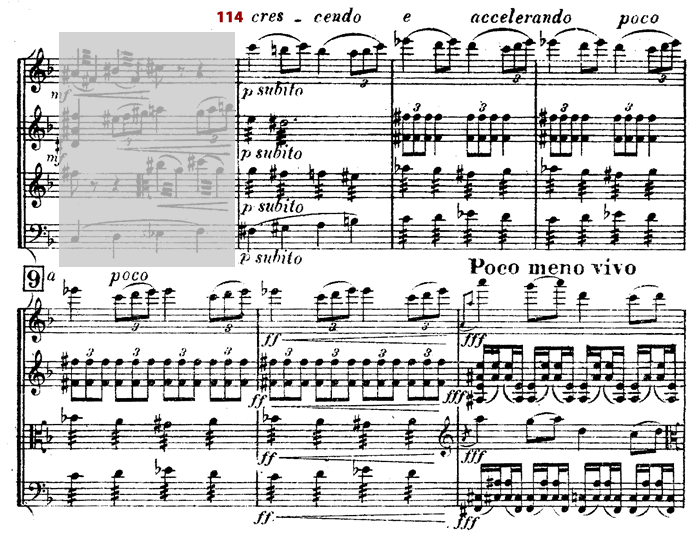
The climax is reached in measure 119:
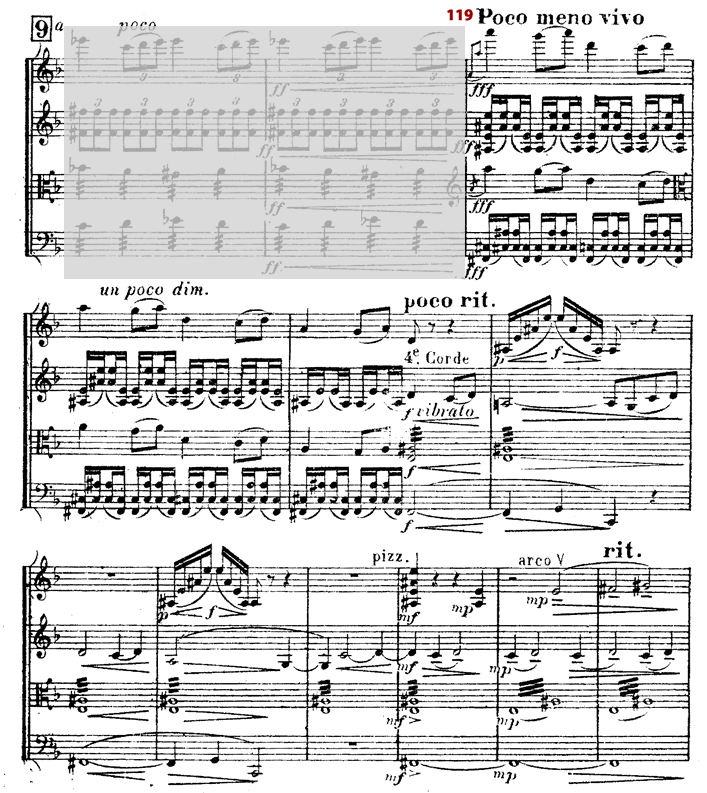
The first violin and the viola continue to play m1 while the cello and the second violin create the harmonic foundation using an F# dominant chord. The chord fifth is a diminished fifth in beats 3 and 4. Ravel seems to establish two different tonal planes: the previously mentioned chord with motive m1 using the notes A - G - A and D - C – D. We could also explain these notes as extensions. A : augmented ninth, G : minor ninth, D minor thirteenth and C the diminished fifth or augmented eleventh.
Listen to the development:
Recording courtesy of Cassatt String Quartet
Recapitulation, first section
The recapitulation structure is similar to that of the exposition. Most changes are of harmonic nature.
The first phrase is identical. The second phrase now uses the D Mixolydian mode (one semitone lower). Some small changes in the first beats are marked:

Measures 137 to 144 that leads to T1 repetition now uses the diminished scale. Compare both versions:
Recording courtesy of Cassatt String Quartet
Recapitulation, transition
The bridge to section B follows the same structure as in the exposition. The first 4 measures are identical. The next 7 measures (157-162) are transposed down a semitone. Small differences are marked:
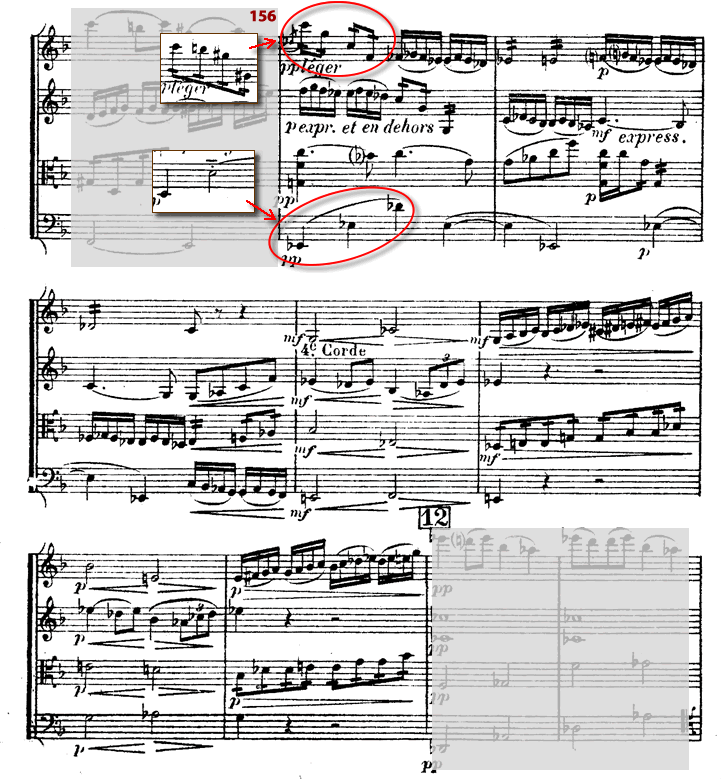
In measures 163 to 166 m1 is transposed one semitone down. The other instruments now use a Db dominant seventh chord (a C# minor seventh chord was used in the exposition):
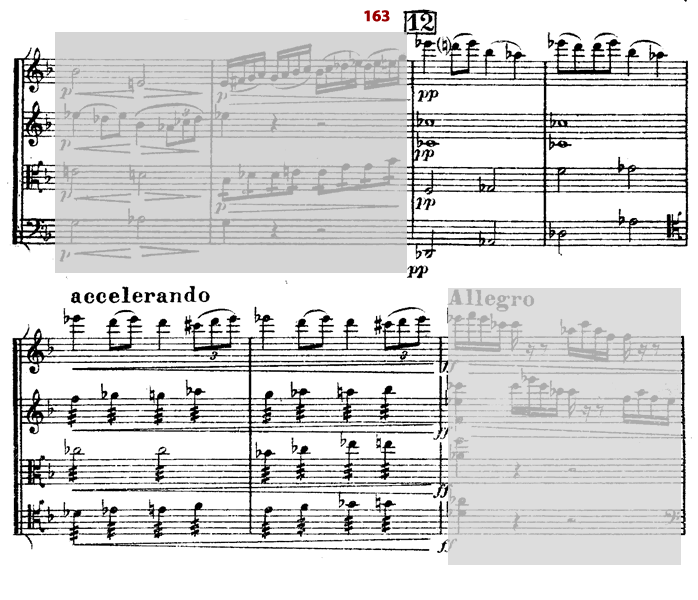
In measure 167 the first violin remains one semitone down in relation to the exposition while the other instruments continue with the same harmony. Measures 169 and 171 are a copy of measures 41 to 43 with some small differences but transposed an ascending minor third. One measure before rehearsal mark 13, a C dominant chord appears. In the exposition this chord was an A dominant chord that prepared the second section key of D minor. We can expect that the C dominant chord will now lead to F following the traditional harmonic plan of the sonata:
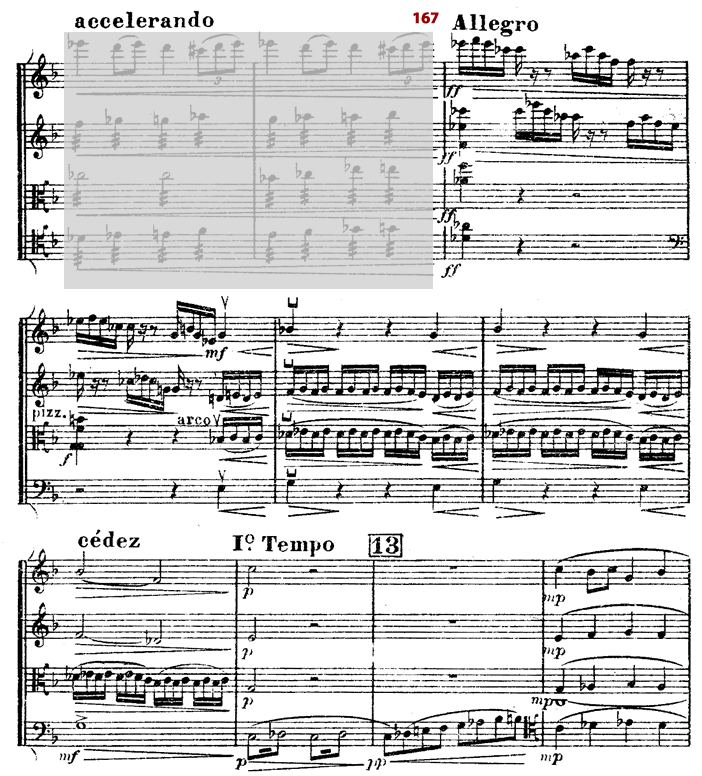
Recapitulation, second section
As expected, the second section starts in F following the traditional harmonic plan of the sonata form. Yet Ravel gives an original twist to tradition. The T3 theme presented by the first violin uses the same notes as in the exposition. Now the second note creates a major seventh with relation to the harmony instead of a major ninth as in the exposition:
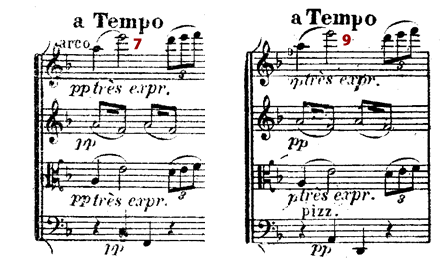
A close inspection of measures 184 to 191 shows that the changes are minimal. The cello in measures 184 and 186 to change the harmony from D minor to F major, and violin and cello in measures 191 to change the A dominant chord into C dominant:
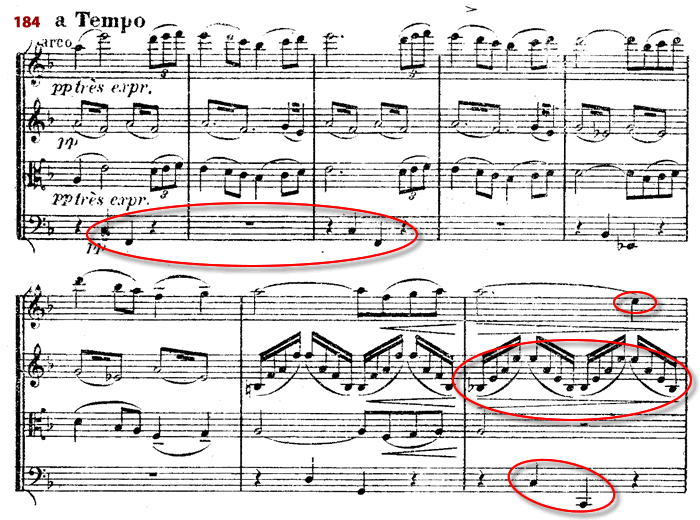
Changes from measure 192 to 200:
- The 6 measures of the exposition are now 9 measures
- The F major harmony is now F dominant
- The T3 is presented by the viola but starts with a third instead of a fifth
- In the last 3 measures the cello and second violin establish a pedal using notes C# - B while the viola insists on the Eb and the triplets
- We find a suggestion of the whole tone scale, but the D and the C of the viola and the Ab of the first violin are not part of the scale
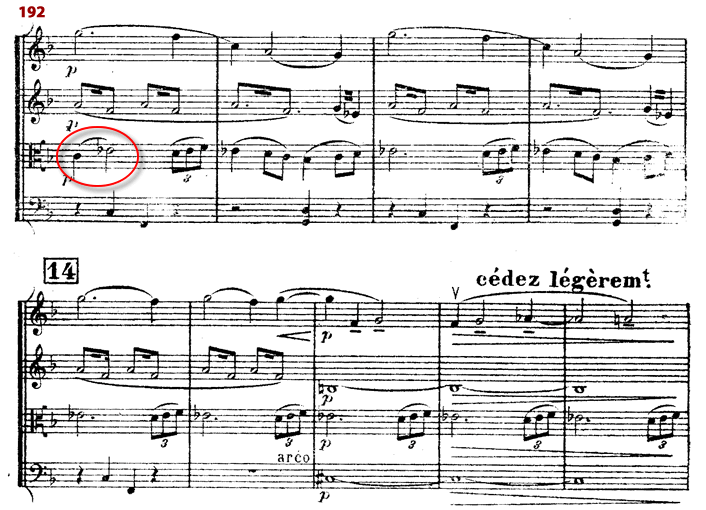
Coda
We arrive to the final coda. The C# - B pedal is present for 3 more measures. The first violin plays motive m1 while the viola continues with the triplets. Three harmonic levels are apparent: one for the violin, another for the viola and the third one for the second violin and the cello:

In the final measures the violins play motives from themes T1 and T3. We start on a B major seventh chord that slowly descends to the final F major chord:
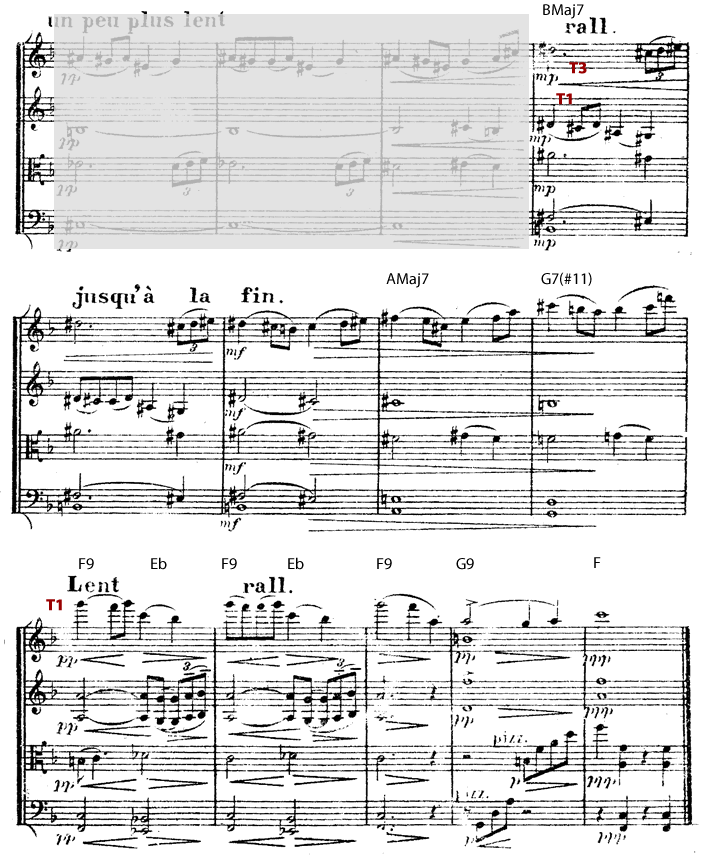
Links:
Complete Movement
Recording courtesy of Cassatt String Quartet